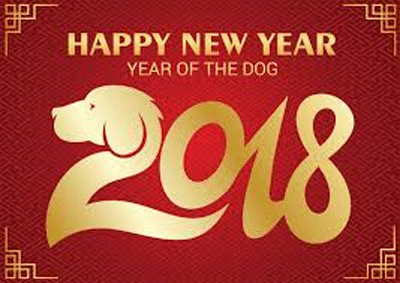The Year of the Dog

Chinese New Year-you may have heard about this holiday, or at the very least, heard about Chinese zodiac animals. The twelve zodiac animals each represent a group of years in which a person was born. Unlike the western zodiac, the Chinese zodiacs are based on fairy tales and folklore. There is one animal per year, and, after 12 years, the cycle restarts.
During Chinese New Year, people celebrate the year’s end, and the start of a new one. This is the Year of the Dog. During this 15 day long festival, the Festival of Lanterns, participants try to cast away bad luck, and replace it with good luck. Chinese New Year is the most important holiday in Chinese culture, as it’s a time to honor household or heavenly deities, and one’s ancestors.
This holiday is based off of the lunar calendar, which can be traced as far back as the 14th century BC, during the Shang dynasty. Also referred to as the Spring Festival or the Lunar New Year, this holiday is full of feasting, festivities, and fun traditions.
Celebrations and traditions for Chinese New Year vary greatly across the country.
In Northern China, they eat dumplings (饺子) filled with cabbage and radish, which is believed to make one’s skin fair and one’s mood gentle. Sometimes, a special dumpling would have a copper coin or a white thread in it. The one who eats the dumpling with the copper coin is believed to be wealthy while the one who eats the white thread will be blessed with longevity.
In Southern China, spring rolls and sticky rice cakes are eaten. When eating sticky rice cakes (年糕), Chinese people often say “年年高” which implies many things, such as getting taller, rising in success within a business, receiving better grades, and earning promotions at work.
Eating and displaying oranges, is believed to bring good luck and fortune due to its pronunciation and writing. The Chinese word for orange, 橙 (chéng), sounds the same as the Chinese word for success, 成 (chéng). Also, 桔, a way to write tangerine, contains 吉, the Chinese character for luck.
Some traditions that both the North and the South celebrate are having reunion dinners with family, giving out red envelopes filled with money, lighting firecrackers, and wearing new clothes. Both the North and the South also watch the CCTV New Year’s Gala. Also known as the “Chūnwǎn” (春晚), it is a live TV program broadcasted on CCTV to celebrate the turn of the New Year. With billions of viewers, the New Year’s Gala features magic shows, dancing, martial arts, acrobatics, and traditional operas. It is a tradition for families to watch the Gala after their reunion dinner.
A week before the New Year, Chinese people clean their houses. This represents a wish to bid farewell to the old year and welcome in a new year. They also put up red decorations because red is a symbol for energy, happiness and good luck. Additionally, they hang up red lanterns and paper cuttings with various beautiful patterns to symbolize the happiness of the coming year.
